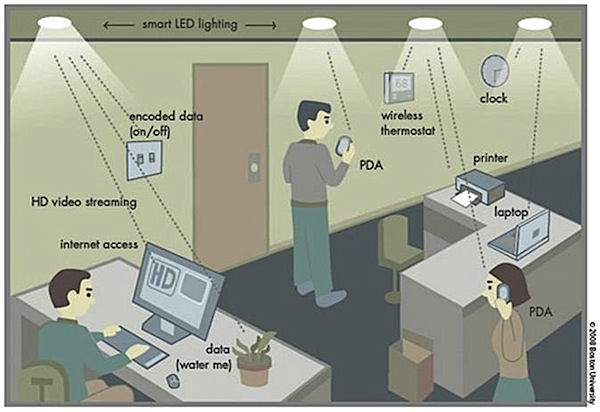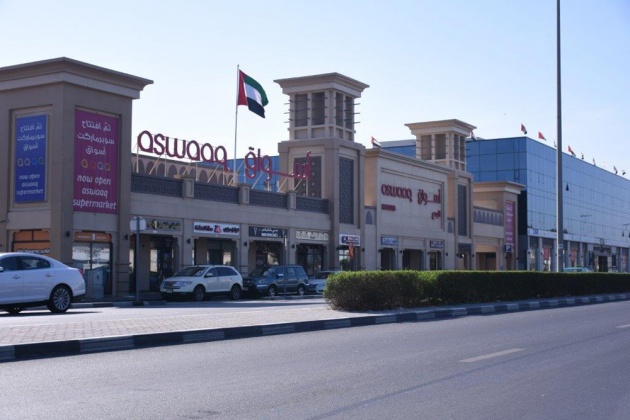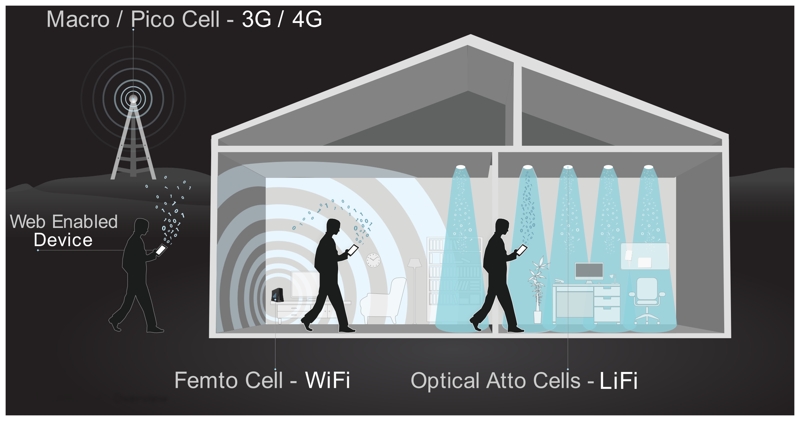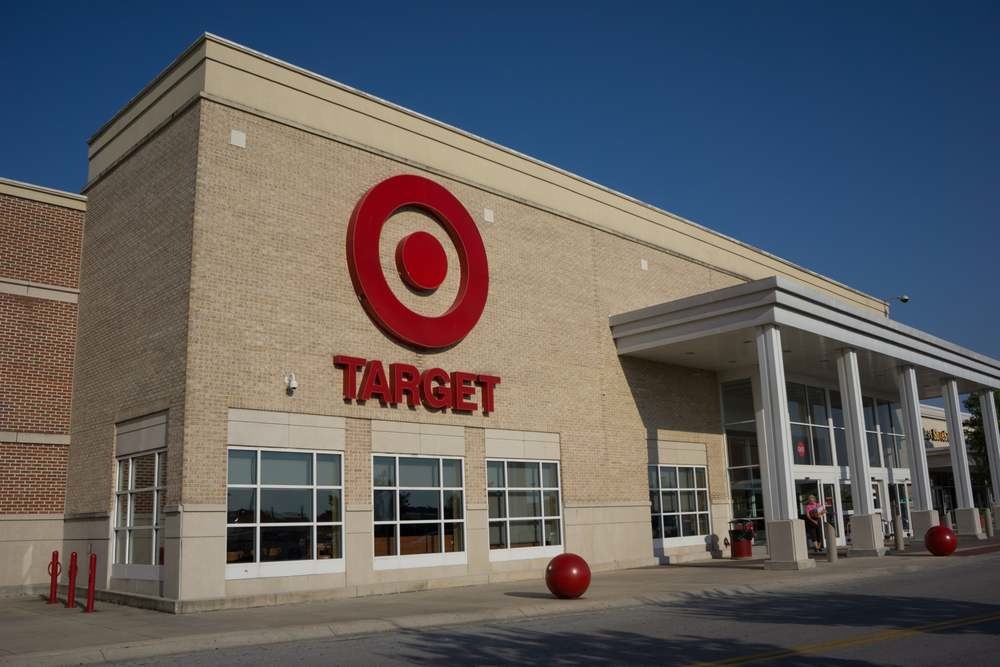TAG | lifi
17
The Brave New World Of The Internet Of Things – The Technologies And Issues
Comments off · Posted by admin in Infographics, LED, Philips LED
The IoT, in which every device can communicate with every other device – even a smart bedcover can ‘talk’ with devices such as Philips’ Hue LED lighting system – is fast becoming a fact of life, like it or not. But how are the IoT technologies evolving, what are the benefits and how about the risks? And how about a wider context? James Hunt explains:

Mario Morales, IDC
The IoT is as of countless ‘things’ that are fitted with uniquely identifiable embedded devices that are wirelessly connected to the Net. These ‘nodes’, as the ‘things’ are called, can send or receive information without human intervention. The nodes can even be fitted to animals (to track or find them), and indeed to people and their clothes – for a variety of reasons we may or may not like.

To achieve this, every ‘thing’ – which could be an LED light source or luminaire, or thermostat, or an industrial controller, for example – must be uniquely identifiable through its embedded computing system, yet it must also be able to interoperate within the existing Internet infrastructure. Such devices are proliferating fast.
With its myriad such devices, including sensors and actuators that ‘talk’ to each other wirelessly and on the Internet, the IoT brings with it an astonishing ability to measure, monitor, and analyse data. This includes, for example, consumer behaviours and buying habits – and not just consumers either, as all businesses can benefit.
Such monitoring and analyses can be used to determine future product developments that will revolutionise the ways in which we live and do business. For the vast majority of homes – made ‘smart’ by IoT devices – everyday life will be enhanced by technology, particularly in terms of entertainment and comfort.
To take just one example – Google and Philips Lighting have got together for Nest Lab’s intelligent wireless thermostat and home automation devices to work with Philips’ Hue IP-connected LED lamps – OSRAM is in on the act too.
Connectivity is the word
When the IoT is augmented with devices such as sensors and actuators, it can then encompass increasingly important technologies such as smart homes, buildings, grids and cities, as well as intelligent transportation. These devices collect useful data with the help of various existing technologies and then autonomously flow the data between other devices – such as those that use Wi-Fi for remote monitoring. But how, in brief, does such connectivity work?
Firstly, there are several types of connectivity used by the IoT. These are:
* Personal Area Networks (PAN)
* Local Area Networks (LAN)
* Neighbourhood Area Networks (NAN)
* Wide Area Networks (WAN).
PANs and LANs are those that most domestic and small business IoT installations are likely to use directly and these are also the ones that the majority of electrical contractors and installers will be involved with.
Those IoT devices that use a PAN with a smartphone will use the smartphone as the gateway to the Internet (WAN). Devices in a smart home or automated building can connect to a LAN and find their way to the Internet too.
So IoT devices use, as the name implies, Internet connectivity, but smart devices that are part of an overall IoT can also use other enabling technologies, such as RFID and near-field communication (NFC), optical tags and quick response codes (a now common example is the QR Code) and a whole range of wireless (Wi-Fi) topologies. The latter include Bluetooth Low Energy, low energy wireless IP networks, ZigBee, Z-Wave, LTE-Advanced (high-speed communication specification for mobile networks) and Wi-Fi Direct (Wi-Fi for peer-to-peer communication without needing to have an access point (AP).
It remains to be seen if any one of these becomes pre-eminent.
Important IoT issues
Away from IoT issues that will affect electrical wholesalers, contractors and installers directly – as opposed to regulators, data centre developers and owners, specifiers and IoT / network device manufacturers – there are a number of problems that will need to be addressed to ensure successful wide-scale take-up.
For example, thousands of IoT devices signaling and sending data to each another take both CPU consumption and a surprising amount of energy. This costs money and has carbon emission implications, so IoT devices should use the minimum energy possible. Though this will not normally affect electrical distributors, contractors and installers, ultra-low-power wireless chipsets should be used in IoT devices and low power networks – such as Bluetooth low-energy, ANT, ANT+, ZigBee, ZigBee RF4CE, Wi-Fi, Nike+, IrDA and the near-field communications (NFC) standard.
Bandwidth take-up is another IoT connectivity issue. Bandwidth on a cellular (mobile) network is expensive, especially with hundreds of thousands of IoT devices sending request/response signals to a server – the result is that the server farm will need to be large enough to handle all the data. With the potential for many billions of devices (possibly even trillions longer term), this will be a huge problem that must be addressed.
Another issue is presence detection of IoT devices. This provides the exact state of all IoT devices on a network and shows immediately when any device drops off the network – or when it comes back on. In this way, the IoT devices can be monitored (and fixed if a problem occurs).
And for those IoT devices that ‘live on their own’ – such as trackers – the connectivity to the wider Internet can be tricky.
Finally, it is important to note that the Internet is not simply one network, and heterogenous networks, proxy servers and security firewalls can all disrupt connectivity. So a fully functioning, all-encompassing IoT is not with us yet as many issues need to be sorted. Even so, the vast majority of Voltimum users will not need to confuse themselves with this level of granularity – most already available smart devices they install for domestic use as part of the IoT will be simple to install and commission. They are already.
At light speed!
Although Wi-Fi has not been in the public domain for too many years – apart from computer routers – it is now an established means of data communication. It is fast and increasingly reliable. Importantly, it is quick and easy to install because expensive and disruptive hard wiring is not needed.
However, there’s a new kid on the block that is even faster – far faster – and it has its own set of advantage and disadvantages. Let’s look at it briefly here:
This important newcomer is Li-Fi, which has as its analogue Wi-Fi, but being based upon light (which travels at 186,000 miles/s) is very much faster – many times faster than conventional Wi-Fi – and possibly up to 10 times cheaper.
Li-Fi (or Light Fidelity) is a form of visible light communication (it can also use infrared and near ultraviolet). It is bidirectional and fully networked and has been described as a ‘new era of wireless connections’. With claimed speeds of up to 224 GBps (though mostly lower), this new technology could enable a high-definition film to be downloaded in seconds.
The change to Li-Fi, when it comes, will be driven mainly by the electrical and lighting sectors through LED lighting. Li-Fi will turn every LED lamp into wireless access points (APs), which effectively allows any user to move between sources without losing the connection. The LED lamps act as the medium to deliver networked, mobile, high-speed communication in a similar manner to Wi-Fi (but much faster). All this then becomes another enabler and part of the IoT.
Li-Fi has the advantage of being suitable for use in areas sensitive to electromagnetic waves such as aircraft cabins, hospitals and nuclear power plants, because it does not cause electromagnetic interference. However, the light waves cannot penetrate walls, so reducing Li-Fi’s scope, and there may be problems in bright sunlight. Such difficulties will have to be addressed before there is widespread use of Li-Fi, but there’s no doubt that this new technology is creating great excitement.
Already there are examples of Li-Fi in the market. For instance, Philips Lighting has developed a system for shoppers in stores. They have to download an app on their smartphones, which then work with the lighting LEDs in the store. The LED light sources can pinpoint where the shoppers are located in the store and give them corresponding coupons and information based on which aisle they are on and what they are looking at.
Li-Fi is very likely, therefore, to change data communication; importantly for the electrical and lighting sectors, it will also generate much-needed new revenue.
Ethernet and Industrial Ethernet with the IoT
The IoT doesn’t only have domestic applications; it has a vast potential in commercial, retail, hospitality and public building sectors too. Then there’s industry – in particular, manufacturing and process plant. A connectivity protocol that is very widely used in IT is Ethernet and its industrial counterpart is the much more rigorous Industrial Ethernet. These, together with Wi-Fi are effectively enabling the Manufacturing Internet of Things – otherwise known more usually as the Industrial Internet of Things (IIoT).
The (IoT) has morphed from its RFID origins to one that encompasses all networked devices, both within and without a manufacturing operation. The big drive to adopt IoT in manufacturing has coincided – says Automation World – ‘with a concurrent enabling trend toward use of Industrial Ethernet and wireless (Wi-Fi) network technologies within the production environment’.
In addition to intelligent sensors and machines, the IIoT also takes in ‘Big Data’, cloud computing, analytics, mobility and what is termed universal visualisation. Manufacturers are aiming to implement the IoT or IIoT to optimise assets, increase production efficiencies and, therefore, improve business performance. This is achieved by gathering data from the many sensors, actuators, other devices, machines and controllers operating on the shop floor. This data is then made globally available via a cloud or similar infrastructure platform to those operators who have the authorisation (and for security’s sake, only them), so that they can monitor and analyse it – and act upon it if necessary.
The application of the IoT and IIoT to industry is really beyond the scope of this article, and relatively few Voltimum users are likely to be involved in the sector, but it is important to note, even so, how the IoT is having a crucial impact here already.
Security and safety will be crucially important
There’s that proverbial fly in the ointment, of course, and this is security, which will be of paramount importance if the future all-encompassing IoT is to work as intended, safely and securely. This is because just about everything (and everybody) will be connected together. The possibilities for hacking, denial of service, fraud and utility- and city-scale disruption are huge.
Indeed, security concerns are developing faster than even the IoT itself. This is especially so when it is considered that IoT devices will be (and already are) connected to smart grids, smart cities, water and gas utilities, energy organisations, transport etc. And domestic smart meters will connect homes to power utilities. Knowing this, the potential for catastrophe is certainly clear, whether by accident, by virus intrusion or via hacking.
So among the many considerations will be to ensure that when sending or receiving data, the IoT device or server must have proper authorisation for that (and every such) action. Also, an IoT device is dangerously vulnerable when it is listening to an open port out to the Internet – ports should not be open, despite the need for bidirectionality. End-to-end encryption between devices and servers will be crucial.
But security doesn’t just mean ensuring that your IoT system is secure from hacking; it also involves privacy and whether you can be spied upon, because the IoT holds the possibility that organisations will be able to intensify personal surveillance. And if they can, you can be sure they will try.
Issues include when someone sells a house with a smart thermostat or garage door, how does the new owner ensure former users can no longer access these devices? And how do manufacturers protect against intrusions into smart TVs and theft of data collected from device cameras and microphones? Such issues have to be addressed to make the IoT safe and secure, now and in the future.
Standards
It is clear that IoT and connectivity standards are already a crucially important, though already divisive topic. After all, how will devices connect to others without interoperability standards? Yet, many devices so far conform to a wide range of often non-interoperable standards.
Cross-industry open source organisation, the AllSeen Alliance (among others) believes that the IoT cannot meet its full potential without an open platform to ensure interoperability between devices from different manufacturers.
Then there’s research by ON World, which finds that the wireless standard ZigBee, already being used by many IoT devices, continues to increase its share of the IEEE 802.15.4 and smart home markets. By 2020, the study claims, ZigBee standards will be used in eight out of 10 of the 802.15.4 chipset shipments.
Furthermore, the Thread Group announced last year that it had completed the specification and documentation for its IP-based wireless networking protocol for low-power connected devices in the home.
These represent just a very few examples of potential interoperability clashes for connected and IoT devices. Therefore, organisations such as the Institute of Electrical and Electronics Engineers (IEEE), the Industrial Internet Consortium (IIC), and the European IoT-A (Internet of Things – Architecture) project, among others, are looking to provide architectural frameworks that define relationships between IoT domains and devices, as well as appropriate security schemes.
As these few examples show, it’s clear that there is much work to do as far as standards and interoperability are concerned.
And finally….
For the future? Well, the World Economic Forum makes five predictions for the IoT, bearing in mind that in the past year alone, IBM has invested £2 billion in its IoT business unit, and AT&T announced a record 1.6 million connected device net additions, including one million IoT-enabled cars, in Q3. Earlier in the year, Samsung declared its commitment to connecting everything it sells by 2020, and GM stated that its OnStar 4G capabilities will generate £242 million in profit over the next three years.
The predictions are:
– That the ‘security of things’ will take centre stage.
– We will stop counting the ‘things’ in favour of more important success metrics to put a premium on the quantifiable impact of new services.
– For the first time, more new cars will be connected than not.
– Low-power wireless area network (LPWAN) technologies will not go mainstream because the technologies are still in their infancy.
– The IoT market will align around a more precise lexicon, meaning that ‘business savvy enterprises will demand accuracy and accountability, resulting in clearer definitions from IoT solution providers’.
internet connected lighting · internet of things · iot · iot led lighting · led lighting · lifi · Novel Energy Lighting · philips hue · wireless control
The Middle East’s first retail outlet with connected lighting which communicates with customers has been unveiled in Dubai. PLUS: Interview with Nordeon chief Patrick van Rossum. Lux Today newscast for Tuesday 29 March is presented by Courtney Ferguson.
led controls · led lighting · lifi · lux review · Novel Energy Lighting · supermarket lifi · supermarket lighting
24
Dubai supermarket is first with connected lighting
Comments off · Posted by admin in Uncategorized
Customers use the app to receive information relevant to the items around them such as special offers and they can even look up prices of items on their phone instead of on the shelves.
Lux reports: UAE supermarket chain Aswaaq has become the first retailer in the Middle East to install connected lighting which communicates with its customers.
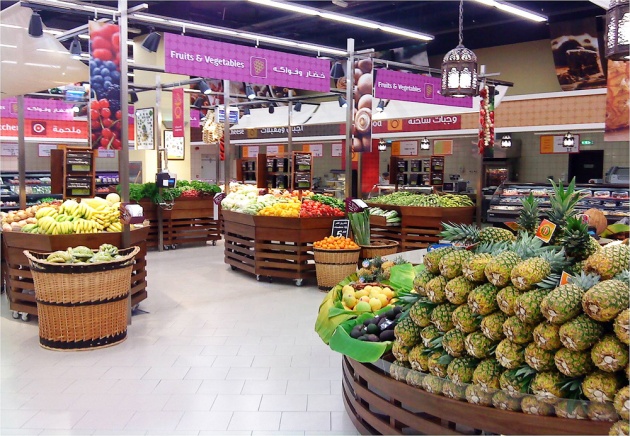
Its supermarket in Al Bada’a, Dubai, now boasts so-called Visible Light Communication technology, which is imperceptible to the human eye but detected by smart phone cameras. The lights act as a positioning system which allows shoppers to find items in the store to an accuracy of 30cm.
Smart-phone owners must first download the Aswaaq-branded app. This allows their phone to communicate with the individual light points transmitting their location through the high-frequency modulation of the light. The data stream is one-way and no personal data is collected by the lighting system.
They use the app to receive information relevant to the items around them such as special offers and they can even look up prices of items on their phone instead of on the shelves. The store managers can use the system to identify the most popular areas of the store to better place products, as well as help streamline tasks such as stock checks and restocking shelves.
The project has been installed by Philips Lighting and an American specialist in ‘digital store mapping’, Aisle411.
Other retailers trialling visible light communication include Target in the US, and Carrefour at its hypermarket in Lille, France.
connected lighting · led lighting · lifi · Novel Energy Lighting · supermarket lifi · supermarket lighting · visible light communication
Smart cities are happening and they will transform exterior lighting companies into flexible, high technology electronics suppliers.
That’s the view of Fadi Shanaah, general manager of Schreder’s operations in the Middle East. He believes that, like the rapid adoption of LEDs, smart cities will become a reality faster than people expect.

‘How fast depends on the region. We’re lucky that the UAE has made big steps towards adopting the technology. Dubai, for instance, is moving quickly thanks to the backing of Sheikh Mohammad and there are people now who are driving it. At the moment it’s at the high-level stage and what’s missing is the detail. But in the coming months and years you’ll start to see those high-level concepts translated into useful technologies that will benefit you and me.’
He believes safety, security and connectivity are the key roles that intelligent lighting will play in smart cities.
‘It’s really exciting – but it’s challenging too. The technology has changed completely so for a lighting company that means moving from being a traditional lamps and luminaires company into become an electronics manufacturer. That means changing your R&D and even changing your people. In Schreder we’re use the phrase ‘beyond lighting’.

‘Look at the big players – Philips, GE and Osram – having to sell their lamps businesses, as that model is dying. They need to change and they need to change quickly because the transition to LED and electronics is happening faster than than people thought.’
Schreder will be exhibiting its first major luminaire range targeting the smart city market at LuxLive Middle East 2016 in Abu Dhabi in April. Shuffle is an ‘integrated smart city luminaire’ with features such as wi-fi, security cameras, public-address speakers, air-quality sensors and electric-car chargers.
It’s really exciting – but it’s very challenging too as it means we need to change our businesses fundamentally”
He believes the low-power wide-area standard LoRa – an open protocol currently being adopted by Cisco and IBM among others – could be a possible candidate for data transfer between street lights in a smart city. Schreder has its own Zigbee-based proprietary system, but Shanaah believes that lighting companies will have to adopt whatever technology gains currency in the smart city landscape.
‘Each city has slightly different priorites and technologies and each will move at its own pace,’ says Shanaah. ‘But there’s no doubt that smart citi
lifi · Novel Energy Lighting · smart cities · smart lighting · smart luminaires
Apple looks set to include a li-fi capability in future versions of the iPhone, meaning it can access high-speed data using lighting.
The backing of a tech giant like Apple would transform the technology from scientific curiousity into a mainstream technique for accessing the internet, and provide a huge boost to the lighting industry.
The iPhone’s operating system now openly references li-fi capability in its programming code.
Li-fi uses modulated visible light from LEDs to transmit data to enabled devices. It’s invisible to the human eye, and is much faster than traditional wifi.
Apple already holds a patent on using its camera to capture data as well as images, so the company is well placed to exploit the new technology.
It’s not the first time this year that Apple has been making news in the lighting industry.
Last month the company added a blue-light reduction feature into an update to its operating system in what was widely seen as the the first acknowledgement by a major manufacturer that blue light can be a health hazard.
In January Apple received its first ever patent for a lighting system, in a move that has again raised the issue of the company’s intentions in the lighting market.
apple led · apple lifi · apple lighting · li-fi · li-fi phone · lifi · Novel Energy Lighting
Tech start-up company Velmenni has used Li-Fi-enabled lamps to transmit data at speeds of 1Gbps. Laboratory tests have shown theoretical speeds of up to 224Gbps.
The company tested the method of delivering data, which uses the visible spectrum rather than radio waves, in a working office.
The visible light spectrum is 10,000 times greater than the RF spectrum used in Wi-Fi, and Li-Fi can achieve about 1000 times the data density of Wi-Fi because visible light can be well contained in a tight illumination area, whereas RF tends to spread out and cause interference.
Velmenni tested the technology in an office in Tallinn, Estonia, to allow workers to access the internet and in an industrial space, where it provided a smart lighting solution.
Speaking to the International Business Times, chief executive Deepak Solanki said that the technology could reach consumers “within three to four years”.
The term Li-Fi was coined by Professor Harald Haas, co-founder and chief scientific officer at Edinburgh-based pureLiFi. He demonstrated the technology at a TED (Technology, Entertainment and Design) conference in 2011.
His talk, which has now been watched nearly two million times, showed an LED lamp streaming video. Professor Haas described a future when billions of light bulbs could become wireless hotspots.
One of the big advantages of Li-Fi is the fact that, unlike Wi-Fi, it does not interfere with other radio signals, so could be utilised on aircraft and in other places where interference is an issue.
But the technology also has its drawbacks – most notably the fact that it cannot be deployed outdoors in direct sunlight, because that would interfere with its signal.
Neither can the technology travel through walls so initial use is likely to be limited to places where it can be used to supplement Wi-Fi networks, such as in congested urban areas or places where Wi-Fi is limited, such as hospitals.
pureLiFi, established in 2012 as a spin-off from the University of Edinburgh, where its research has been in development since 2008, demonstrated a commercial Li-Fi network system, Li-Flame, this year at a major mobile technology show in Barcelona. “This is developing very quickly – it’s just a question of maturity,” says Nikola Serafimovski, pureLiFi’s director, product marketing. “My expectation is that this will be a widespread technology in a 24-month timeframe.”
Picture: pureLiFi
For more lighting news visit www.novelenergylighting.com
led lighting · li-fi · lifi · Novel Energy Lighting · wifi lighting · wireless lighting
25
Target’s IoT trial expands to 100 stores
Comments off · Posted by admin in LED, LED downlights
internet of things · iot · led ceiling lights · led lighting · lifi · lux · Novel Energy Lighting · target stores · visible light communication · vlc



